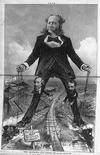Part 2: Modern Nation- Gilded Age through Progressive Era Flashcards
Government policy of non interference with the free market system. Led to many companies creating monopolies or trusts.

LAISSEZ FAIRE
period in the mid and late 1800s which resulted in a new burst of economic growth as a result of innovation, invention, increased manufacturing.

SECOND INDUSTRIAL REVOLUTION
Causes of America’s Second Industrial Revolution
1. Natural Resources
2. Legacy of the First Industrial Revolution
3. Role of Government: Patent/free market
4. Stimulus of the Civil War

Partner with John D. Rockerfeller in Standard Oil. This tycoon helped to develop Florida by building, railroads and hotels throughout the State.
HENRY FLAGLER

Leading Banker, financier in the 19th century. Founded General Electrics and one of the worlds largest Bank.
John. P Morgan
AKA JP Morgan

19th century philosphy which held that most succesful individuals were born with superior talents which allowed them to adapt, survive and thrive. This philosophy als held that the poor were to blame for their condition instead of circumstances or institutional injustices.
SOCIAL DARWINISM
Entrepeneur who created created a line of comestic products for African American Women

Madam C.J. Walker
Immigrant who was born in Scotland started US Steel which at the time was the largest Steel company in the World.

ANDREW CARNEGIE
Group of workers who organize in order to negotiate better wages and benefits from business owners
Labor Unions
Largest and most influential labor union in the 19th century. Their power and number decline after the violence which resulted from the Haymarket Square Riot of 1886

Knights of Labor
Nationwide labor organizion that was founded by Samuel Gompers, a Jewish immigrant. AFL Members were restricted to skilled workers

American Federation of Labor
AFL
A process which reduced the cost of making steel by more than 80% percent. As a result it hep to spur economic growth in the United States.

Bessemer Process
Credited with the invention of the Telephone in 1875

ALEXANDER GRAHAM BELL
When one oner controls all companies and facilities at one strage of production of a good. I.E. John Rockerfeller who bought up 90% of all the oil refining companies in the US.

Horizontal Integration
When a company controls all the stages of the production and distribution (shipping) of a product.

VERTICAL INTEGRATION
system characterised by social ownership and democratic control of the means of production. An ideaology popular by many members of labor unions

Socialism
rally which was organized by labor radicals to protest the killing and wounding of several workers by the Chicago police during a strike the day before at the McCormick Reaper Works. One of the protester threw dynamite at the police which resulted in the seven police and four protestors. Led to the reduced popularity of labor unions

Haymarket Square riot
Steel workers strike at US Steel factory. Strikers were fired by management and “blacklisted” from future employment in the steel industry. Steel workers union collapesed.

Homestead Strike
Strike organized by Labor leader Eugene Debs at a Railroad Car company. United States President sent troops to end the strike stating that mail had to be delivered. This event led to the decline of the American Railway Union and another example of Government supporting Business owners over workers.

Pullman Strike
Inventor of many things including the phonograph, light bulb, and motion pictures.

THOMAS EDISON
When a company has total control over an industry. Many were formed in the late 1800s because of the government’s laissezfaire (hands-off) attitude. Companies used the theory of Social Darwinism to justify their unfair business practices.
MONOPOLY

Used in textile mills and coal mines especially. Paid less than adults. By 1910, as many as 1 out of every 5 children under 15 years old was working outside the home.

CHILD LABOR
1882 law banning Chinese immigration of skilled and unskilled laborers for a period of ten years. The act was periodically renewed and not repealed until 1943.

CHINESE EXCLUSION ACT
Japanese government’s (1907-08) agreement to limit emigration of unskilled workers to the U.S. in exchange for the repeal of San Francisco’s segregation order that had separated Japanese children and put them in a separate school.

GENTLEMAN’S AGREEMENT ACT

























